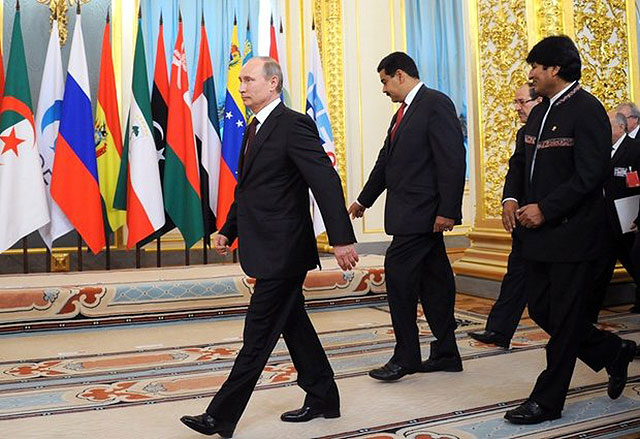The much-discussed “shale revolution” threatens to weaken Russia’s regime, which has grown dependent on traditional energy exports. Donald N. Jensen, Resident Fellow at the Center for Transatlantic Relations at the Johns Hopkins School of Advanced International Studies, suggests that the Kremlin has finally noticed this phenomenon—but has so far done little to prepare for it.

In his speech at the July summit of the Gas Exporting Countries (GECF) in Moscow, Vladimir Putin took verbal aim at the “shale revolution” that is undermining Russia’s preeminence in the global energy sector, weakening its geopolitical position, and, perhaps, threatening the regime itself. “We need to move toward closer integration,” Putin told heads of state and ministers from eleven countries in the gilded Hall of St. Catherine in the Great Kremlin Palace, in order to avoid “unfair pressure.” The worldwide increase in access to shale gas and other types of unconventional gas, he said, was a “serious challenge” for all members of the GECF.
Each key point in Putin’s remarks—his call for predictable rules of the game, reliance on long-term contracts, and matching gas prices to those of oil, and his opposition to the EU Third Energy Package and insistence that development of Russia’s substantial shale reserves was not on the Kremlin’s agenda—aims to preserve an international energy system Moscow has used to advance its interests for many years. Russian officials have often criticized shale gas for costing too much and ruining the environment, but until very recently, they have minimized the threat. As recently as this spring, Alexei Miller, head of Russian energy giant Gazprom, described the shale revolution as a “myth” and a “bubble that will burst soon.”
Hydrocarbons have accounted for half of GDP growth since 2000 and provided at least half of the state’s budget revenues last year.
Under Putin’s rule, hydrocarbons have become central to Russia’s geopolitical ambitions. Russia is one of the two largest oil producers in the world (the country accounts for 12 percent of global output) and one of the largest exporters of oil. Russia is also the top producer of traditional natural gas, accounting for about 20 percent of the global total, and exports gas to Europe, a major market. Gazprom controls a large number of subsidiaries and shell companies to limit public resistance to its investments, including key infrastructure assets. It has gained direct access to industrial and power generation sectors in Western and Central Europe. In the past, Russia has been so confident of the power of its energy weapon that it could bully clients: in 2006 and 2009 it cut off gas supplies to Ukraine during contract negotiations.
Gazprom is also at the core of the regime’s domestic stability. Putin postulated before he became president that the revival of the state from the “chaos of the 1990s” should be based on state ownership or outright control of the energy sector. The state would be the major political and economic actor in Russia. The private sector, civil society, and political institutions would play a secondary role. Indeed, hydrocarbons have accounted for half of GDP growth since 2000 and provided at least half of the state’s budget revenues last year. They have also been the engine driving Russians’ increased incomes, especially in Moscow and St. Petersburg.
Yet recent developments suggest that the Russian energy sector, especially Gazprom, is no longer the leviathan it once seemed. The “shale revolution” has transformed the United States from a declining energy power to the world’s biggest gas producer and a potentially large exporter, driving down the price of gas on the world market. Supplies of liquefied natural gas from the Middle East that the US no longer needs are being offered to European countries—current Gazprom customers—that are using this new leverage to bargain for lower prices from Moscow. Other nations, such as Poland and Ukraine, hope to develop their own shale supplies, for strategic as well as economic reasons.

Vladimir Putin at the GECF summit in Moscow.
As a result, the value of Gazprom has plummeted. In 2008 it had a market capitalization of more than $350 billion, and Miller speculated it would become the first trillion-dollar “company” (it has always been difficult to determine whether Gazprom is an arm of the Russian state or vice versa). Today it is worth about $80 billion. The European Commission’s Third Energy Package would force Gazprom to sell its pipelines, and the commission is starting an antimonopoly investigation of Gazprom that will include scrutinizing the giant’s actions for possible price fixing. This contraction of the European market means that Gazprom must find alternative customers, such as China, a prospect that is uncertain. As economist Anders Åslund recently noted, Gazprom management is marked by extreme inertia, reluctance to absorb new information, corruption, and outlandish arrogance.
Russia’s energy sector is also threatened by factors that go far beyond the challenge of shale or Gazprom’s problems. First, Russia’s vulnerability to oil price fluctuations has increased as its dependence on energy exports has grown. Most experts say that Russia needs oil to be priced at more than $100 per barrel if the federal budget is to be balanced. Second, the state has shown symptoms of having contracted the “Dutch disease”—that is, its overreliance on commodity exports has depressed other sectors of the economy by starving them of investments (at the same time, the increasing value of the ruble has made non-commodity exports more expensive and less competitive on world markets). Finally, vast corruption has accompanied the rise of Russia’s petro-state. Kickbacks and informal deals over budget funds are routine. “Practically all elites are addicted to the injections of informal income,” writes political analyst Stanislav Belkovsky. “Many state officials understand that they should fight this addiction, but cannot resist another dose.”
As new, cheaper sources of energy emerge, Russia needs to lessen its dependence on traditional energy exports.
Russia’s leaders are clearly aware of these challenges, no matter their public rhetoric. Gazprom’s domestic competitors, such as Novatek and Rosneft, which are controlled by oligarchs close to Putin (Gennady Timchenko and Igor Sechin, respectively), are lobbying Putin to break Gazprom’s grip on gas exports. Rosneft, Russia’s largest oil producer, hopes to double its share of the domestic gas market by 2020—at Gazprom’s expense—in part by developing shale. At the recent St. Petersburg Economic Forum, Rosneft and Novatek signed agreements with customers on exports of liquid natural gas without Gazprom being involved. Sechin has also taken the lead in expanding exports to China and Venezuela.
Over the short to medium term, Russia’s macroeconomic performance is likely to survive the “shale revolution.” Its hard currency reserves are second only to China’s, its budget is balanced, and inflation is relatively low. But as Leon Aron, director of Russian studies at the American Enterprise Institute, has warned, the status quo is not sustainable indefinitely. As new, cheaper sources of energy emerge and the market becomes more competitive, Russia needs to lessen its dependence on traditional energy exports if it is to avoid stagnation and possible political and economic crisis. This will require political reforms and a far greater commitment to the rule of law—changes that would also threaten the current regime. Putin’s GECF remarks suggest that the Kremlin is at last taking the “shale revolution” seriously, but there is little sign that he is taking the necessary steps to prepare for it.

